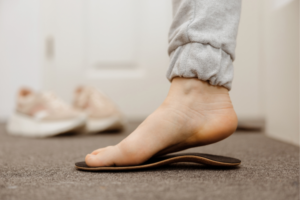
What is Involved in Nail Surgery?
A common concern we hear is that Nail surgery is scary and extremely painful. I’m here to tell you that this is not the case! Keep reading to find out more..



There is nothing worse than finding a new pair of running shoes that are really suitable for your feet, only to find that they are too loose or tight just in one area. Having grown up with very wide feet myself, I often struggled with this until I discovered simple changes you can make to your shoe laces to accommodate for differing foot types. The three most common issues I encounter in the clinic with shoe fitting are related to heel slipping, bunions/a wide forefoot and wide feet.

Have the laces crossing over like you would normally – but leave the top set of eyelets open. Instead of crossing over, feed the laces through on the same side from the outside until you leave a small loop. Once you have done this on both sides feed the laces through the loops on opposite sides and pull them tight. This will help to secure the heel and prevent it from slipping.

Remove the laces so you only have them in the bottom two eyelets. Feed the laces through the next set of eyelets on the same side from the inside, then again on the same side but from the outside. Once you have done this on both ends of the shoelace cross over like would normally until you run out of eyelets. This technique places less pressure on the forefoot area to accommodate for those with bunions or a wide forefoot.
I have used all three of these techniques for shoelaces in the clinic and they are a very simple but effective way of accommodating for areas of the foot/ankle that need to be more secure or need more space. Leave a comment below if any of these help you out! As always, if you are unsure about any of the above or need help with shoe fittings or changing the way you lace your shoes, come and see us in the clinic and we will be happy to help you
Remove the laces so that they are only in the first set of eyelets. Feed the laces through the opposite eyelets for the set above as normal, then cross them over again but this time skip a set of eyelets. Repeat this until you run out of eyelets to feet the laces through. This method ensures that the foot is still supported firmly within the shoe, but allows for more expansion of the tongue and upper to accommodate for those with wider feet.
Hope you all have a great day!
Richy – Sole-Lution Podiatry

A common concern we hear is that Nail surgery is scary and extremely painful. I’m here to tell you that this is not the case! Keep reading to find out more..

Heel pain is one of the most common complaints that we hear in the clinic. Regardless of what it is caused by…

Ask any podiatrist and they will tell you how often they get asked by their patients “Do I need custom orthotics”? The answer is not as simple as most people think…